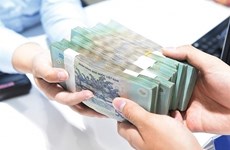Gov’t aims to boost public service payment through banks
The Government will continue to fine-tune legal regulations to popularise the payment of public services through banks, deputy governor of the State Bank of Vietnam (SBV) Nguyen Kim Anh said.
 The number of ATMs in remote areas is modest (Illustrative image. Source: vietnamfinance.vn)
The number of ATMs in remote areas is modest (Illustrative image. Source: vietnamfinance.vn)Hanoi (VNS/VNA) - The Government will continue to fine-tune legal regulations to popularise the payment of public services through banks, deputy governor of the State Bank of Vietnam (SBV) Nguyen Kim Anh said at a forum on accelerating the payment of public services via banks held in Hanoi on August 24.
The Government early this year approved a project on fostering the payment of public services, such as tax, electricity, water, tuition, hospital fees and social and public welfare programmes, via banking.
Accordingly, the Government has set itself a target of collecting 80 percent of tax payments in cities through banks and enabling treasuries in all provinces and cities to have cashless payment systems by 2020.
Non-cash payments are expected to be accepted by 70 percent of electricity and water suppliers, all universities and colleges, and 50 percent of hospitals in major cities. Meanwhile, some 20 percent of social welfare payments will be made through banks.
Bui Sy Loi, vice chairman of the National Assembly’s Committee on Social Affairs, said that the payment of public services through banks should be accelerated as it helps limit the amount of cash in circulation, thereby reducing costs related to printing, transporting, preserving and destroying old and torn money.
Anh said that the payment via banks for public services is still modest, with focus mainly on the customer groups being institutions and firms in big cities and provinces.
Pham Thanh Du, deputy director of the Vietnam Social Insurance’s Finance and Accounting Department, said that the number of people who receive monthly pensions and social insurance in bank accounts makes up for a small proportion compared to the number of beneficiaries. Only 21 percent of monthly pensions and social insurance were paid to bank accounts by February this year, mainly in big cities.
Du attributed the limit to the long-standing habit of using cash only. The number of ATMs in remote areas is modest, he said.
According to Pham Tien Dung, director of SBV’s Payment Department, some policies, bank infrastructure and local habits on the use of cash are hindering such transactions.
“The connection between banks and service providers is still restricted while the information exchange and data access relating to the payment of public service are also limited,” Dung said.
According to SBV’s reports, 50 banks currently provide tax and customs payment services while 26 banks are involved in providing electricity and water payment services, and 11 banks are implementing tuition fee payment services for students at universities.
The report also showed that payments via Internet reached 127 million transactions with value of more than 8 trillion VND (341.27 million USD) in the first six months of 2018, rising by 50 percent in number and 32 percent in value year-on-year.
Mobile payments in the period also surged by 32 percent in volume and 144 percent in value year-on-year to reach 81 million transactions and 676 billion VND.- VNS/VNA













